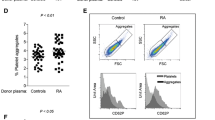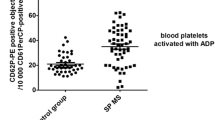Abstract
We evaluated the significance of platelet activation in patients with rheumatoid arthritis (RA). The expression of CD62P and CD63 by platelets was determined using flow cytometry in 18 active RA patients, 10 remission RA and 15 normal controls. Meanwhile, the erythrocyte sedimentation rate (ESR) and C-reactive protein was also determined in all groups. The expression of CD62P in active RA patients (11.88 ± 2.47%) was significantly higher than that in remission RA group (2.85 ± 1.60%; P < 0.01) and control group (2.78 ± 1.04%; P < 0.01). The expression of CD63 in active RA patients (9.90 ± 3.02%) was significantly higher than that in remission RA group (4.11 ± 2.00%; P < 0.01) and control group (4.13 ± 1.85%; P < 0.01). The level of CRP (54.33 ± 23.35 mg/l) and ESR (86.06 ± 33.67 mm/h) in active RA patients was higher than that in remission RA group (2.55 ± 1.01 mg/l, 14.70 ± 4.57 mm/h; P < 0.01 for both) and normal control group (3.21 ± 2.18 mg/l, 12.25 ± 5.05 mm/h; P < 0.01 for both). There was a positive correlation between CD62P and ESR (r = 0.5224, P < 0.01) and also a positive correlation between CD62P and CRP (r = 0.7048, P < 0.01) as well as between CD63 and ESR (r = 0.4476, P < 0.05) but no correlation between CD63 and CRP. Platelet activation may be a sign of RA exacerbation.
Similar content being viewed by others
References
Altman RD, Bloch DA, Bole GG Jr et al (1987) Development of clinical criteria for osteoarthritis. J Rheumatol 14(Suppl):3–6
American College of Rheumatology Ad Hoc Committee on Clinical Guidelines (1996) Guidelines for the management of rheumatoid arthritis. Arthritis Rheum 39(5):713–722
American College of Rheumatology Ad Hoc Committee on Clinical Guidelines (2002) Guidelines for the management of rheumatoid arthritis: 2002 Update. Arthritis Rheum 46(2):328–346
Bathon JM, Martin RW, Fleischmann RM et al (2000) A comparison of etanercept and methotrexate in patients with early rheumatoid arthritis. N Engl J Med 343(22):1586–1593
Boers M, Verhoeven AC, Markusse HM et al (1997) Randomised comparison of combined step-down prednisolone, methotrexate and sulphasalazine with sulphasalazine alone in early rheumatoid arthritis. Lancet 350(9074):309–318
Breedveld FC, Dayer JM (2000) Leflunomide: mode of action in the treatment of rheumatoid arthritis. Ann Rheum Dis 59(11):841–849
Bresnihan B, Alvaro-Gracia JM, Cobby M et al (1998) Treatment of rheumatoid arthritis with recombinant human interleukin-1 receptor antagonist. Arthritis Rheum 41(12):2196–2204
Conn DL (2001) Resolved. Low-dose prednisone is indicated as a standard treatment in patients with rheumatoid arthritis. Arthritis Rheum 45(5):462–467
Jiang Y, Genant HK, Watt I et al (2000) A multicenter, double-blind, dose-ranging, randomized, placebo-controlled study of recombinant human interleukin-1 receptor antagonist in patients with rheumatoid arthritis: radiologic progression and correlation of Genant and Larsen scores. Arthritis Rheum 43(5):1001–1009
Klippel JH (2000) Biologic therapy for rheumatoid arthritis. N Engl J Med 343(22):1640–1641
Pendl GG, Robert C, Steinert M et al (2002) Immature mouse dendritic cells enter inflamed tissue, a process that requires E- and P-selectin, but not P-selectin glycoprotein ligand 1. Blood 99(3):946–956
Genbacev OD, Prakobphol A, Foulk RA et al (2003) Trophoblast L-selectin-mediated adhesion at the maternal-fetal interface. Science 299(5605):405–408
Ma YQ, Geng JG (2000) Heparan sulfate-like proteoglycans mediate adhesion of human malignant melanoma A375 cells to P-selectin under flow. J Immunol 165(1):558–565
Frenette PS, Mayadas TN, Rayburn H et al (1996) Susceptibility to infection and altered hematopoiesis in mice deficient in both P- and E-selectins. Cell 84(4):563–574
Frenette PS, Wagner DD (1997) Insights into selectin function from knockout mice. Thromb Haemost 78(1):60–64
Hartwell DW, Wagner DD (1999) New discoveries with mice mutant in endothelial and platelet selectins. Thromb Haemost 82(2):850–857
Acknowledgement
This work was supported by the grant from the Public Health Bureau of Shanghai Municipality (044Y07) and the Sixth Hospital Affiliated to Shanghai Jiaotong University (0239).
Author information
Authors and Affiliations
Corresponding author
Rights and permissions
About this article
Cite this article
Wang, F., Wang, NS., Yan, CG. et al. The significance of platelet activation in rheumatoid arthritis. Clin Rheumatol 26, 768–771 (2007). https://doi.org/10.1007/s10067-007-0550-0
Received:
Revised:
Accepted:
Published:
Issue Date:
DOI: https://doi.org/10.1007/s10067-007-0550-0




